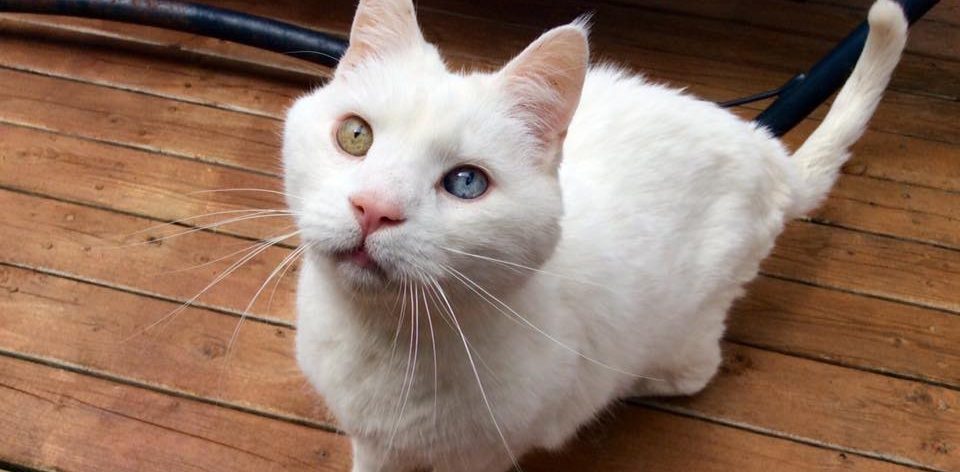Cat Training Basics

Dogs have masters, cats have servants, so the saying goes. Dogs want to earn the approval of their humans. Cats have no such need. Quite the opposite, they often seem to have a sense of entitlement for the food and attention their servants provide. But that doesn’t mean they can’t be trained. It just means that your approval is not going to be an adequate reward. They understand rewards perfectly well. But they need to learn on their own terms, and so the key is allowing them to access the rewards without bossing them around too much. There are a lot of advantages to training your cat.
Cats need sufficient stimulation to be happy. Training and performing the tricks provides that, lessening the likelihood of behaviour problems. It’s an opportunity for bonding, which is good for both of you.* It functions as a substitute for hunting for your cat — they have to work for the reward. (But not too hard!) And it can help you help your cat out of danger — for example, if your cat comes when they’re called, it’s a lot easier to catch them if they escape out the door. Here are some cat training basics to help you get started.
General Training Tips:
1. Arm yourself with treats. The more your cat likes the treats you use, the easier it will be.
2. Get your cat’s attention (see #1, above). If they’re not remotely interested, try again another time. It’s important to start training when your cat feels like it. Don’t force it, as that qualifies as bossing them around.
3. Keep the sessions short and sweet and frequent. Repetition helps learning in cats as well as humans.
4. When you succeed, repeat. If your cat successfully completes a trick, do it 5 or 10 times more, giving them a treat each time. Repetition helps learning in cats as well as humans. 😉
5. Don’t use the ‘cue word’ (e.g. sit, come) until your cat has learned the trick. Once they’re doing it, use the word when you give them the treat.
6. Don’t punish your cat if they don’t get it right. Cats are motivated to learn by rewards, not negative reinforcement. Just try again later.
Easy Cat Tricks
Come
This one’s easiest if you do it at mealtimes. Call your cats name and rattle their food bowl to get their attention. When they come, give them a treat. When your cats get used to coming when they’re called, start incorporating the command (er, request) when you give them the treat. Repeat until they’re responding reliably, and then try getting them to come from a longer distance or a different room.
Sit
With your cat standing in front of you, put a treat in front of their face and get their attention. Slowly move it backwards, towards the cat’s ears. Most cats will try and follow the treat and lower their backside to get access. If they do, or even get close to sitting, it’s treat time! If they don’t, try holding the treat a little closer to their head until you get it right. (Obviously, it’s you that’s doing it wrong, not the cat. Isn’t it always?) Once they’ve done it right, start using the word ‘sit’ when you give them the treat. And just because they do it right a few times, don’t stop training: repeat 5 to 10 times per session and do five or six sessions. Don’t move on to the next trick unless they do the trick reliably.
High Five
With your cat standing a few feet in front of you, wait until they lift a paw off the ground and give them the treat when they do. Then put a treat in your hand and close your first. Wait for the cat to use their paw to try and get it out of your hand. Give a treat when that happens. Repeat, over and over, incorporating the phrase ‘high five’ and gradually raising your hand until the gesture resembles the human one. Again, do several brief sessions until your cat can do the trick reliably, and only then move on to the next trick.
Sit Up
Hold a treat above your cat’s head, but not so close they can reach it when standing or sitting. When your cat sits up on their hind legs and reaches for the treat, give it to them. If your cat doesn’t respond, try holding the treat a bit closer. It may also help to hold the treat fairly close to their face and then move it slowly upwards. You can also try smellier treats. When they perform the trick, use a phrase – just make sure it’s different than ‘sit.’ We use ‘up up’ but any word will do – just be consistent.
There are lots of other tricks your cat can do. We’ve even heard of cats that are toilet trained! Check out the Cat Trick Guiness Book of World Record Holder here.
*Psychosocial and Psychophysiological Effects of Human-Animal Interactions








